How To Use A Word Template
In Microsoft Word, templates are pre-designed documents that you or someone else (such every bit Microsoft) creates to employ every bit a pattern for a project. The template could be for a business card, brochure, resume, presentation…the listing goes on. Regardless of the purpose, templates provide the design consistency that any organization (or individual) needs to await professional. (You tin also detect templates for Excel, PowerPoint, and other applications, but in this commodity we're focusing on Microsoft Word.)
The template contains a specific layout, style, design and, sometimes, fields and text that are common to every use of that template. Some templates are so complete (such as concern cards), you only accept to change the private's proper name, phone number, and email address. Others, such as business reports or brochures, could require that everything is inverse except the layout and pattern.
Once y'all create a template, you can use it over and over. Remember that while you open a template to first a projection, you save the project as some other file type, such as the basic .docx Word format, for editing, sharing, printing, and more. The template file stays the same, unless or until you want to change it (more on that later).
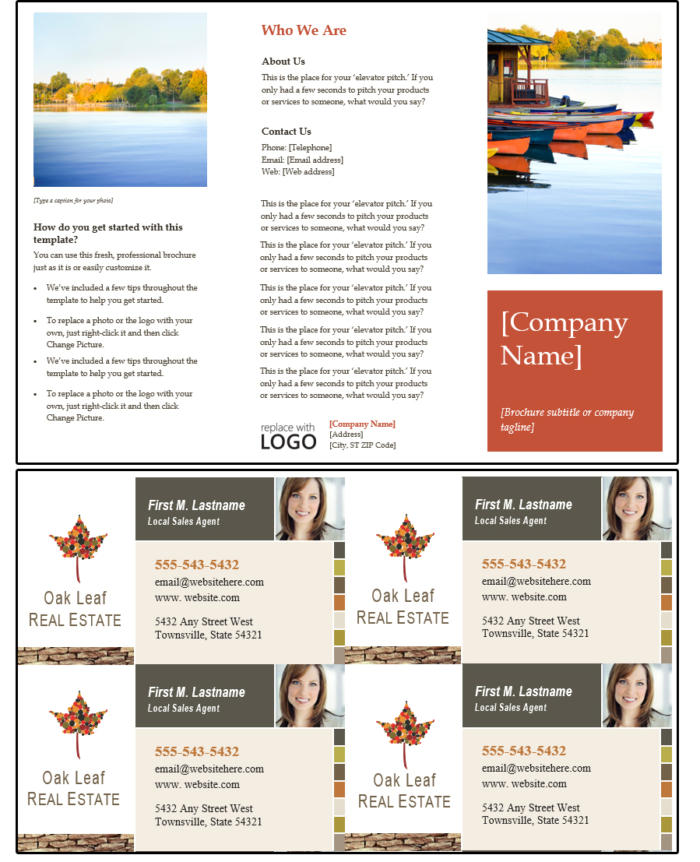 JD Sartain / IDG Worldwide
JD Sartain / IDG Worldwide This is a sample template in Microsoft Word.
How to access Microsoft Give-and-take's stock templates
Fortunately for the states, Microsoft provides many hundreds of templates for all of its programs. Annotation that well-nigh of Microsoft'due south templates are online, which ways you cannot access them unless y'all're connected to the Internet.
To open one of the system-provided templates in Word:
ane. Open up Microsoft Word and select New.
2. Peruse the Suggested Search categories: Business organisation, Personal, Industry, Design Sets, Events, Instruction, or Letters. For this exercise, select Business.
3. Word displays a message that says, "Searching thousands of online templates."
4. Word displays template search results on-screen, plus a comprehensive list of categories in a scrolling panel on the right.
5. Curl down the page or cull a different category, then select a template that fits your current project.
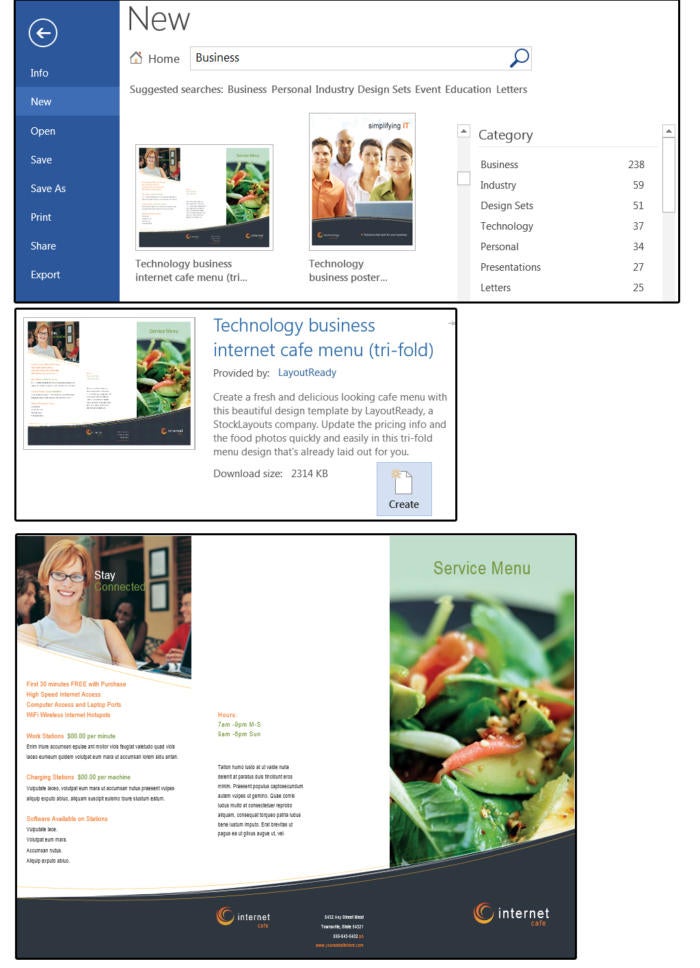 JD Sartain / IDG Worldwide
JD Sartain / IDG Worldwide Select a template from a category, then showtime filling in your ain data and images.
We selected the Internet Café template. Notice the photos, graphics, and main information, such equally hours, are already created in the template. Yous just take to type over the existing data with your company's data, and the brochure is complete.
How to alter a Microsoft Word template
You can change the colors, font, photos, logo, and anything else on this template. If yous have not selected the Cyberspace Café brochure, please do so at present. Before y'all make any changes, go ahead and save this template with a new filename.
1. If you follow normal certificate-saving procedures (and you can here), you select File > Relieve As > Computer > Scan. And then navigate to the applicable folder and requite the template a new name.
two. Remember that once y'all click the down pointer beside the Save As Blazon in the input box and select Give-and-take Template (*.dotx) from the list (and modify the name, of form, in the File Name input box), Microsoft automatically puts the file in its own template folder.
iii. One time saved every bit a template, close the file.
4. Now open it once more. Note that it is non in the folder you specified. Don't panic. Navigate to C:UsersownerDocumentsCustom Role Templates and your custom templates are in that location. Select the one yous just saved from the list and open up it.
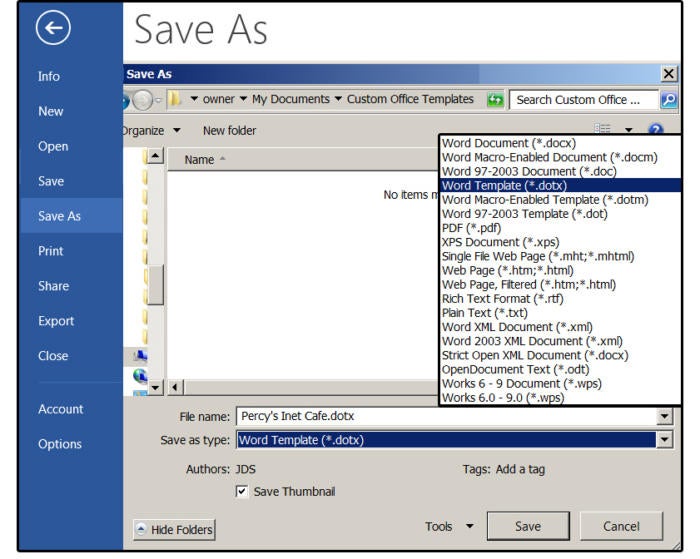 JD Sartain / IDG Worldwide
JD Sartain / IDG Worldwide Salve the document as a template.
5. Change the sections on the new template that will be on every brochure, such equally the logo, or contact information. Then save it as a template again by pressingCtrl+ S. It volition salvage in the same location.
6. Next, fill up in all the other information and save it—this time, as a certificate, then you lot can impress information technology out or share it with others.
Whenever you're set up to create a new brochure, just open the template, enter the new data, and relieve the completed brochure as a document.
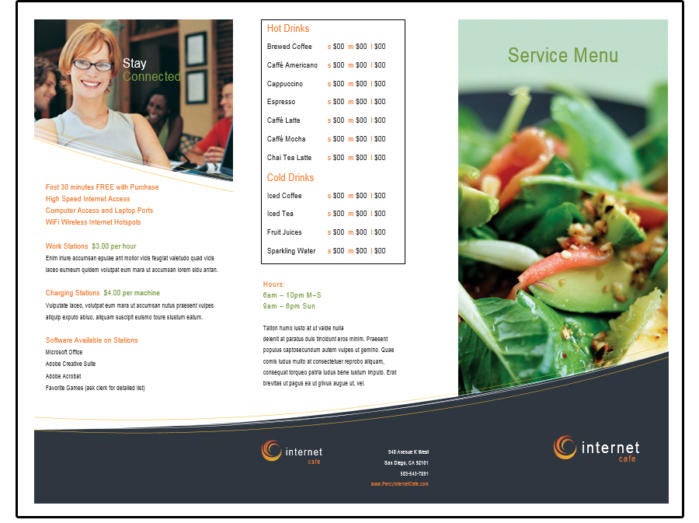 JD Sartain / IDG Worldwide
JD Sartain / IDG Worldwide This Internet Café template has been modified and saved as a document brochure.
How to create custom templates in Word
Custom templates can be as simple or circuitous as needed. For example, you lot might create a template for your company'south newsletter, posters for a seminar, or invitations for corporate events. You can also create interactive templates to load on the Intranet, then others can fill in the blanks to impress their own envelopes and letterhead, for instance.
Start, create a document—design and format it, add graphics and photos. If it's interactive, select Controls from the Developer tab and create custom input fields for user interaction.
For this exercise, create an announcement flyer for a Meet & Greet conference including tiffin, cocktails, and dinner for the company's senior management and its new interns.
1. Start with a blank certificate.
2. Create ii columns: The left is 4.5 inches and the right is 2.5 inches, and the infinite betwixt the columns is about 3/eight of an inch. These measurements are but suggestions. Adjust as necessary for your project and the images and graphics you choose.
three. Add a title.
4. Choose a font (we're choosing Century Gothic), mode (sans serif), and colour (white), for that title.
5. Repeat this procedure for a subtitle. In our example, we're irresolute the font color to dark teal.
vi. Create some graphic boxes for the championship (dark teal) and the subtitle (calorie-free teal). Select Insert > Shapes and choose a rectangle from the icon list.
vii. Insert an applicable photo in both columns. Choose Insert > Pictures and select photos from your Pictures Library. Calculation images gives y'all an opportunity to eyeball image sizes and column widths and adjust them equally needed.
8. Enter the schedule and agenda in cavalcade ane. Employ Century Gothic fourteen (in black) for the body text and Century Gothic xviii (in dark teal) for the headers.
9. Enter the time and identify plus the briefing hosts in column two, with the same fonts and colors for the body text and headers.
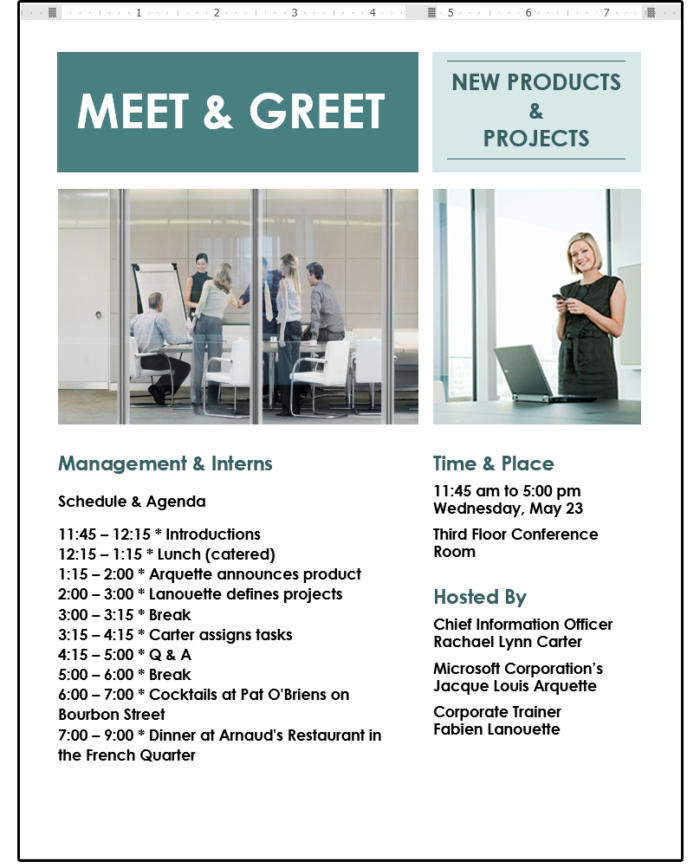 JD Sartain / IDG Worldwide
JD Sartain / IDG Worldwide Create a custom event template.
x. One time satisfied with the concluding product, click Save As > Meet+Greet.docx (a regular Word document), and then you tin can share or impress.
11. Before you get out, as well salvage this document equally a template. Click Salvage As > Salvage Every bit Type, choose Word Template [*.dotx] from the listing, and save as Meet+Greet.dotx. Side by side conference, the template is ready to get y'all started.
In one case yous accept some custom templates in your Custom Office Templates folder, when you lot open Word and select New, Word provides a new category on the backstage menu called Personal. Click this category to meet and open your saved templates.
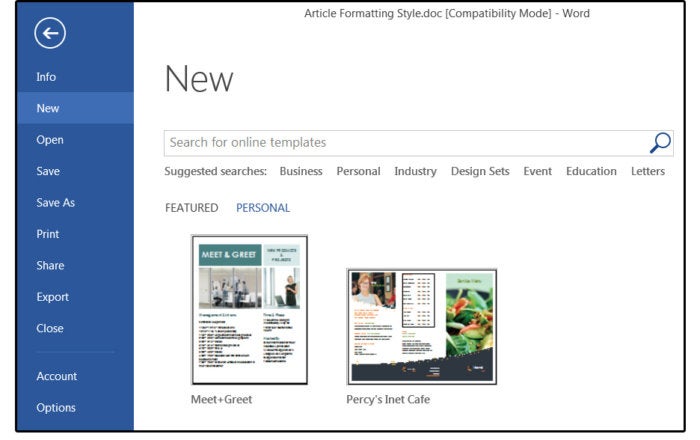 JD Sartain / IDG Worldwide
JD Sartain / IDG Worldwide Open up your custom template under New > Personal.
How to add an interactive component to a template
Some templates use interactive controls for user input. For case, imagine that once a month, the branch managers, assistant managers, and loan originators of a large banking institution take a meeting at ane of the 12 branches. It's your assistant's job to email the date, time, location, speakers, topics, and agenda to each attendee. Rather than have that person retype the data in a regular template, y'all can create a template where options can be chosen from a list. For example:
one. Start, create the template, then decide which fields (appointment, time, etc.) tin be selected from a listing.
ii. Click the Programmer tab.
three. Position your cursor on the template where the date goes.
4. Select Insert > Text > Quick Parts > Field, then cull Appointment from the Categories console and select a date format from the Properties console. Click OK. Now the date will update automatically.
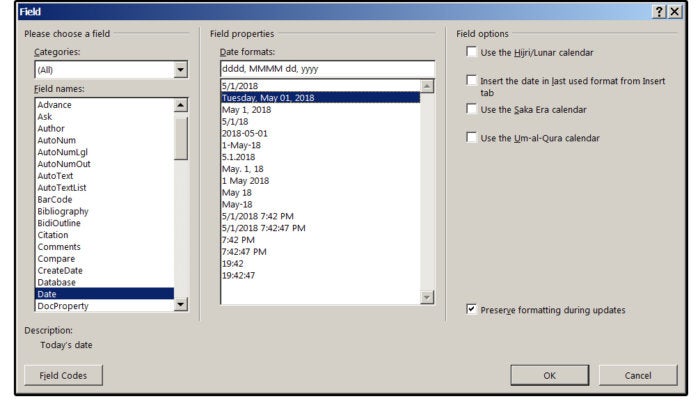 JD Sartain / IDG Worldwide
JD Sartain / IDG Worldwide Insert a appointment field that automatically updates.
5. Next, position your cursor on the template where the location goes.
6. Select Programmer > Controls > Combo Box Content Control. Give-and-take places this detail on your template.
vii. With the Developer tab still selected, click Controls > Properties, and the Content Control Properties dialog window opens.
8. Click the Add push, enter a branch name in the Add Pick dialog box, then click OK. Repeat this procedure until all the branch locations are entered, then click OK again to close this dialog window.
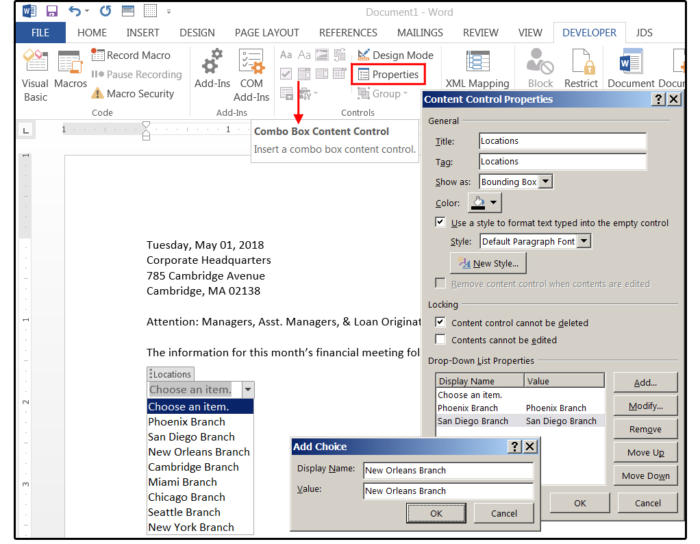 JD Sartain / IDG Worldwide
JD Sartain / IDG Worldwide Create a Philharmonic Box Control and then users can select options from a list.
9. If you lot desire to alter, remove, or move an entry up or down, highlight the entry, then click the appropriate button.
10. You tin can modify the color of the Philharmonic Box frame and change or create a custom style (fonts, color, attributes, etc.) for the typeface used within the Philharmonic Box.
11. Repeat steps v through 8 above to create Combo Box Content Controls for the remaining fields: coming together date and time, speakers, and topics.
12. When finished, salvage the document as a Give-and-take Template (*.dotx).
Template tips: how to create custom stylesheets
The default stylesheet in MS Word is chosen normal.dotx. It's non a good idea to modify this stylesheet because, later on on, it could result in some unwanted effects. Information technology's best to create custom stylesheets for each custom template. For case, the normal.dotx font is Calibri, paragraphs are left aligned, spacing is i.xv, etc. Heading one is Cambria 16 signal, etc. You can change these settings manually throughout your certificate without saving them to the normal stylesheet, and earlier you save the certificate as a template.
Once satisfied, use those custom settings for your new stylesheet, which could exist named something like to the template name. For example, if you're creating a custom brochure template, you might name it and the stylesheet Brochure1. And so future brochures will be much easier to blueprint.
1. Choose the Dwelling tab, and so click the small-scale arrow in the bottom right corner of the grouping called Styles. From the driblet-down bill of fare, click the New Styles push button (bottom left).
2. In the popup dialog Create New Style from Formatting, enter the proper name of the fashion, such as Brochure1.
3. Next select Paragraph from the Mode Blazon field listing, which affects the unabridged paragraph, as opposed to a Character style, that affects only the characters inside a paragraph.
4. Y'all tin can choose to make the style based on another style, such as the Normal manner, one of the Header styles, or No style. If you lot plan to use well-nigh of the formatting features in the Normal style except a few differences, then base it on the Normal style. If the custom style will exist completely dissimilar, then choose the No manner option.
five. Under Formatting, select a Font and Size, then cull a Font Color such every bit Brown, Alignment such as Justify, Spacing such every bit i.15, and Indents. Notice that the box in the centre of the dialog window shows how the paragraph looks with the format options you lot select.
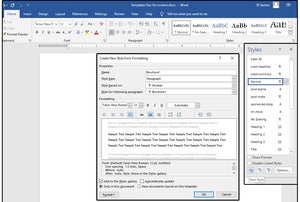 JD Sartain / IDG
JD Sartain / IDG How to create a custom stylesheet
half-dozen. In the bottom left corner, click the Format button. Observe the nine options in the drop-downwardly list. In the Font dialog, y'all can further customize the font options such equally font style (assuming, italic, etc,), underline style; Sub- and Superscript, Small Caps, etc.
7. In the Paragraph dialog, you can customize the Indents & Spacing and the Line & Page Breaks. Use the Tabs dialog to customize the alignment and the leader of your tabs, such as the dots betwixt the chapter name and chapter page number on a table of contents.
viii. The Borders & Shading dialog provides Border options such every bit Box, Shadow, 3D, etc.; and Shading options include colors and patterns. The Linguistic communication characteristic is, of class, the language of the paragraph such as French or Italian. Note that if you want but specific words in some other language, such as c'est la vie in the middle of a paragraph, then create a character style called French.
9. The Frame option is actually the Text Wrap feature, which includes how the text wraps effectually a graphic in a paragraph, the spacing around the graphic, and how it's positioned on the folio. Choose Numbering to define how you want the numbers to appear such every bit the arabic numbers, Roman Numerals, or Characters; how they are spaced; and delineated such every bit with a period later on or parentheses, etc. Bullets are also defined under this list pick, which provides standard and custom bullets.
10. Side by side is the Shortcut Key options, which lets you choose a custom Shortcut central for your Paragraph or Grapheme way, such as Ctrl+B for bold (which is a Word default), or define your own. Last on the list is Text Effects, which lets you define the color, gradient, design, outline, and transparency of a paragraph such as the title on the title folio of a book or manual. Additional Text Effects include Shadow, Reflection, Glow, Soft Edges, and 3D Format.
 JD Sartain / IDG
JD Sartain / IDG How to format a custom stylesheet
Where to notice the template files on your computer
The custom templates that you create or change from ane of Microsoft's stock templates are stored at C:UsersOwnerDocumentsCustom Office Templates, where <Owner> is your login proper name. When you open the Users binder, yous'll see your login name on the list of folders. If not there, information technology should be in the folder that's really chosen Owner.
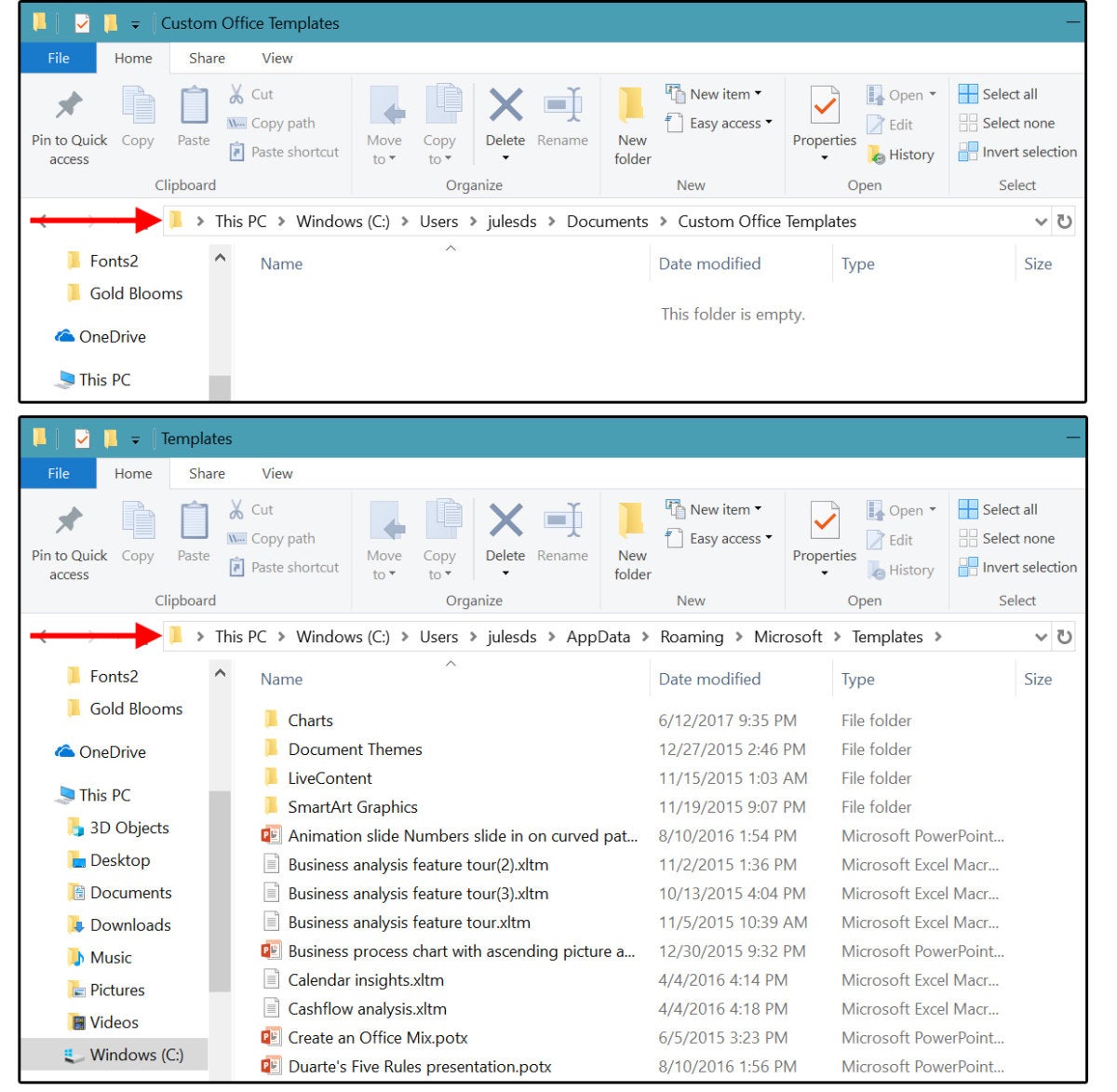 JD Sartain / IDG Worldwide
JD Sartain / IDG Worldwide Where the personal custom templates and the stock templates are located
Microsoft stores its templates at:
C:Users<your login name>AppDataRoamingMicrosoftTemplates
Again, if yous failed to create a unique login name, this folder may be called <Owner>. If yous tin can't find information technology, the AppData folder and all of its files and subfolders are subconscious.
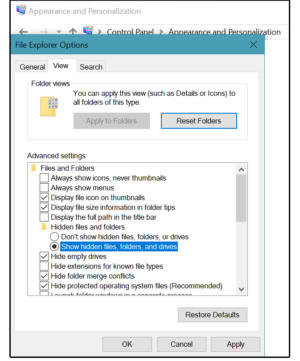 JD Sartain / IDG Worldwide
JD Sartain / IDG Worldwide Show Hidden Files and Folders
To view the Hidden files:
- Select the Get-go/Windows button > Control Panel > Appearance and Personalization
- Select File Explorer Options/Folder Options > Show hidden files and folders
- On the side by side screen, check the tick marking beside Show hidden files, folders, and drives, then click Apply and OK.
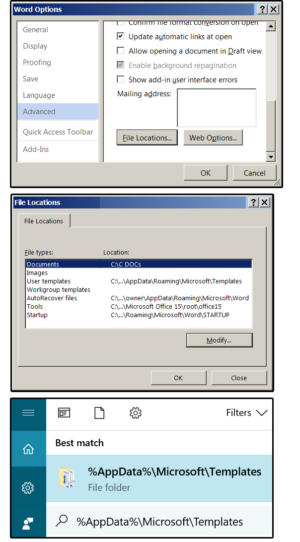 JD Sartain / IDG Worldwide
JD Sartain / IDG Worldwide Two more than ways to locate the stock templates folder
To discover the actual proper name of the Templates folder:
- Select File > Options > Avant-garde
- Scroll most ii-thirds of the way downwardly the screen.
- Click the File Locations button, and the File Locations window appears.
- Word displays the locations and paths to all the template-related files.
Y'all can too click the Outset button, then copy and paste this: %appdata%MicrosoftTemplates in the Search box and press Enter. The Templates folder appears in the Starting time box. Double-click to get straight to the stock templates folder.
How To Use A Word Template,
Source: https://www.pcworld.com/article/401866/microsoft-word-templates-how-to-use-modify-and-create-them.html
Posted by: emersonwaallovar.blogspot.com


0 Response to "How To Use A Word Template"
Post a Comment